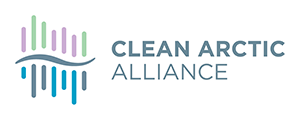The Arctic Climate Crisis
As the summer sea ice recedes due to climate warming, Arctic waters are becoming increasingly navigable to shipping. The amount of shipping in the Arctic is increasing as reduced sea ice opens up access to Arctic resources, while interest in shorter shipping routes through the Arctic is growing. Emissions of carbon dioxide (CO2) and black carbon (BC) from oil-based fuels used by ships including heavy fuel oils (HFOs) – one of the world’s dirtiest fuels – enter the atmosphere causing warming.
Despite regional and global efforts, ships’ CO2 and BC emissions continue to rise – with BC emissions from shipping in the Arctic increasing 85% between 2015 and 2019. When the BC settles onto snow and ice it accelerates melting, and the loss of reflectivity creates a feedback loop with more heat being absorbed, speeding up melting further and exacerbating global heating. BC emissions also have health impacts for local communities, while a spill of HFO, discharges from scrubbers used to circumvent the need to use fuels with reduced sulphur content, and discharges of wastewater have devastating consequences for the sensitive Arctic ecosystem, wildlife and its residents, including the food security of indigenous communities.
The Clean Arctic Alliance’s vision is protection of the unique Arctic ecosystem, including summer sea ice, dependent wildlife and Indigenous communities, from the polluting impact of shipping both in the region and beyond. This will be achieved through international campaigns focused on advocacy with decision-makers, collaboration with local communities, engagement with the shipping industry and communication across a variety of platforms focused in Arctic and Arctic-observer countries, as well as countries which flag ships choosing to use Arctic routes.

